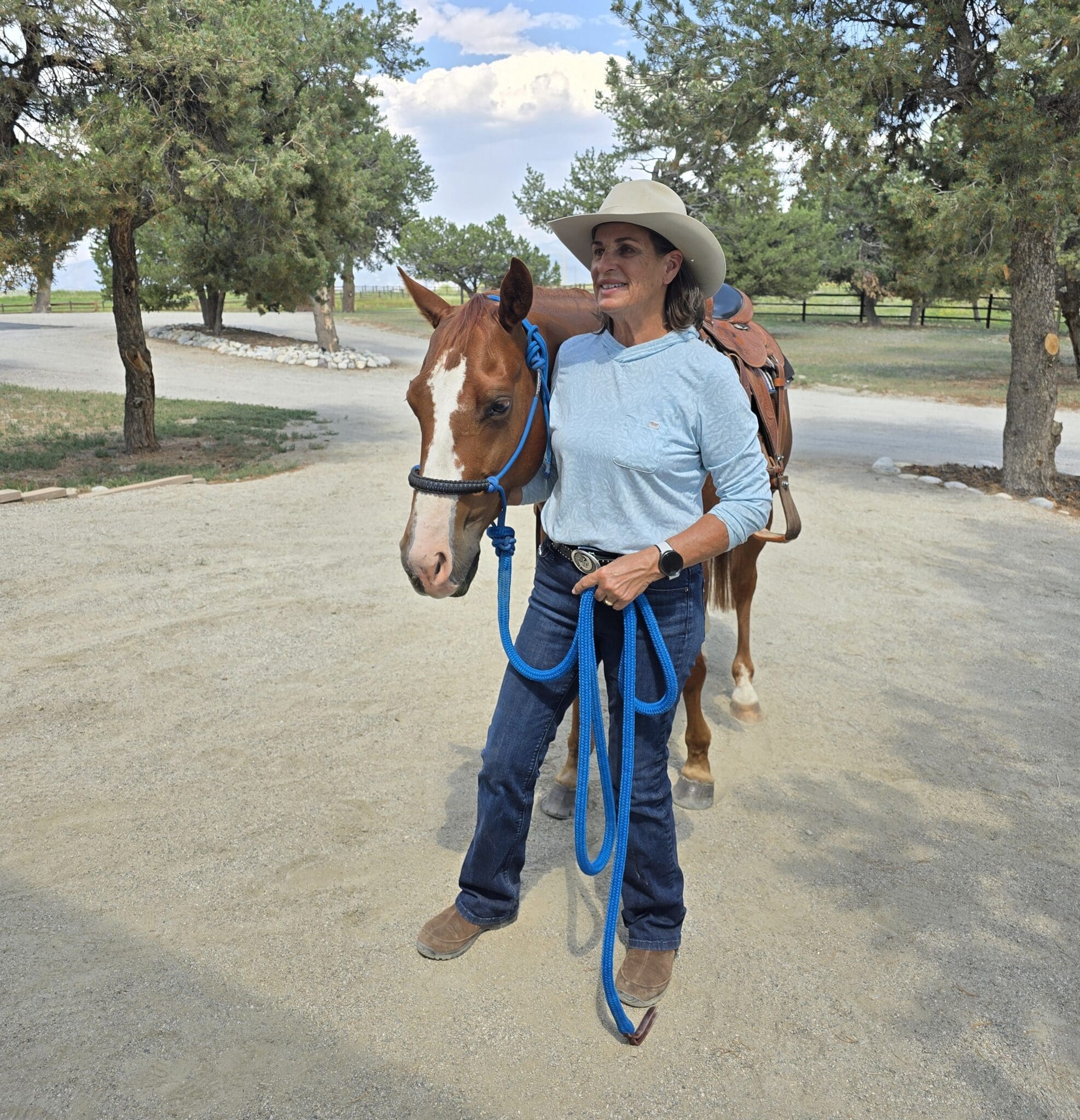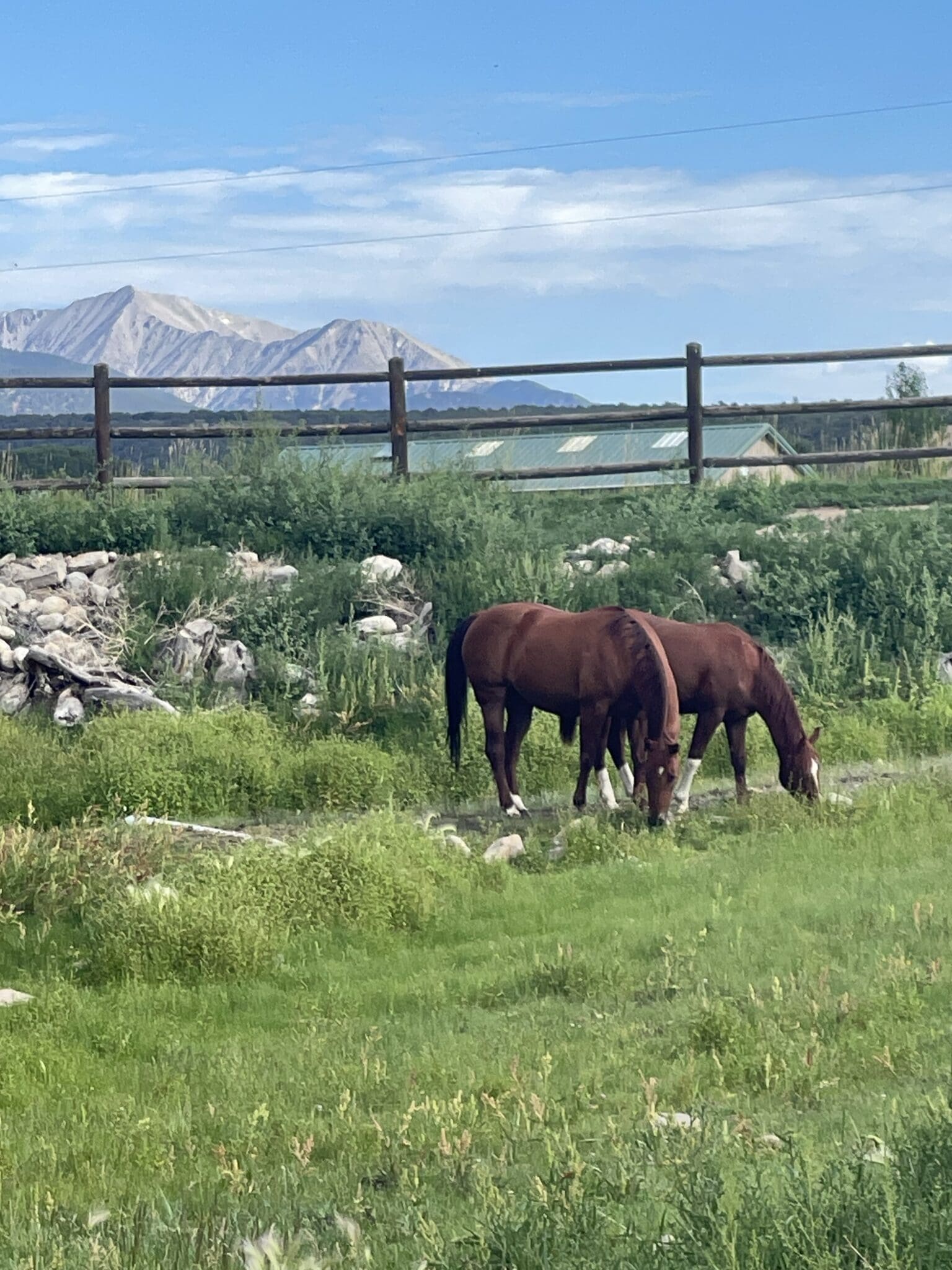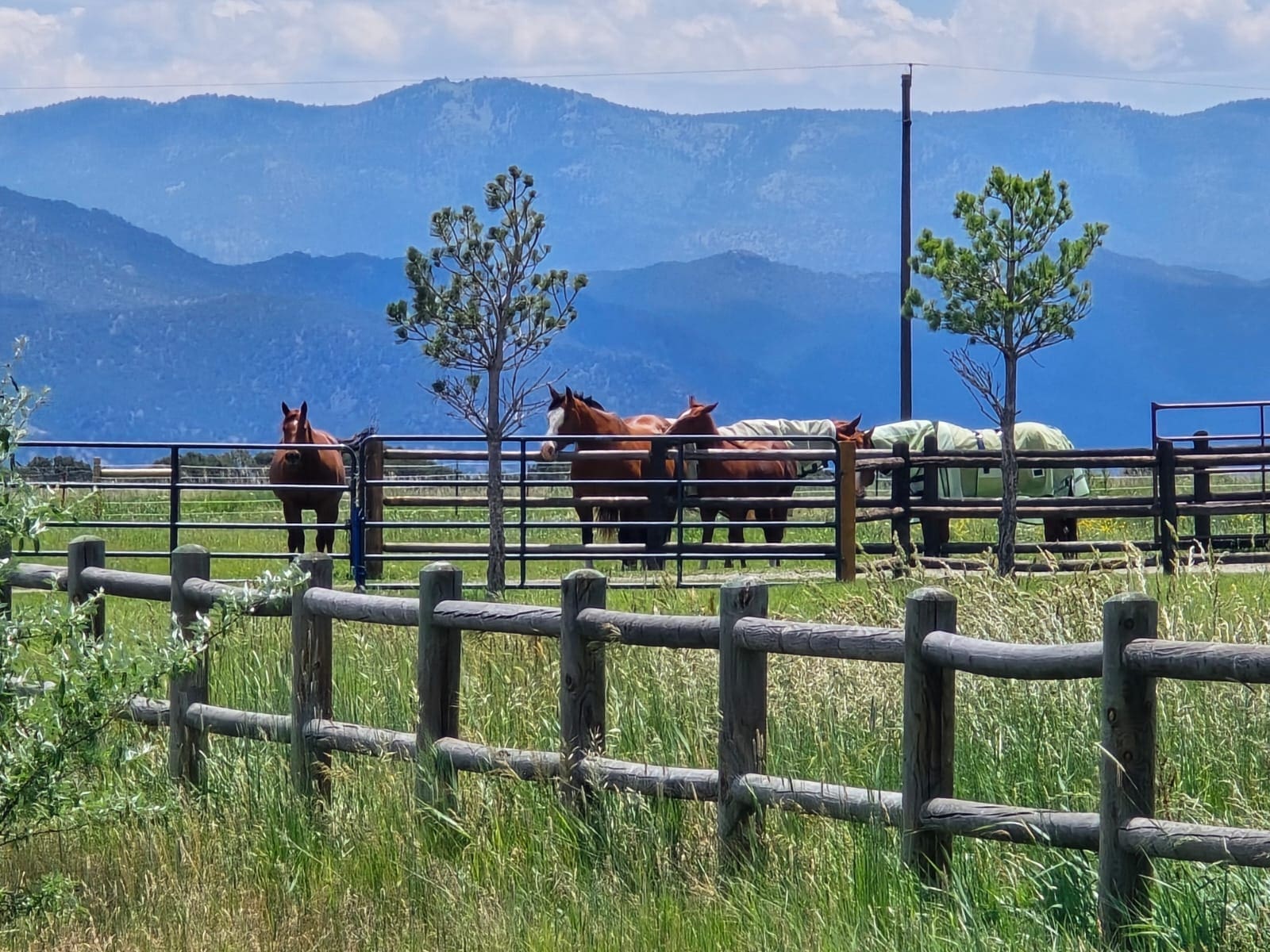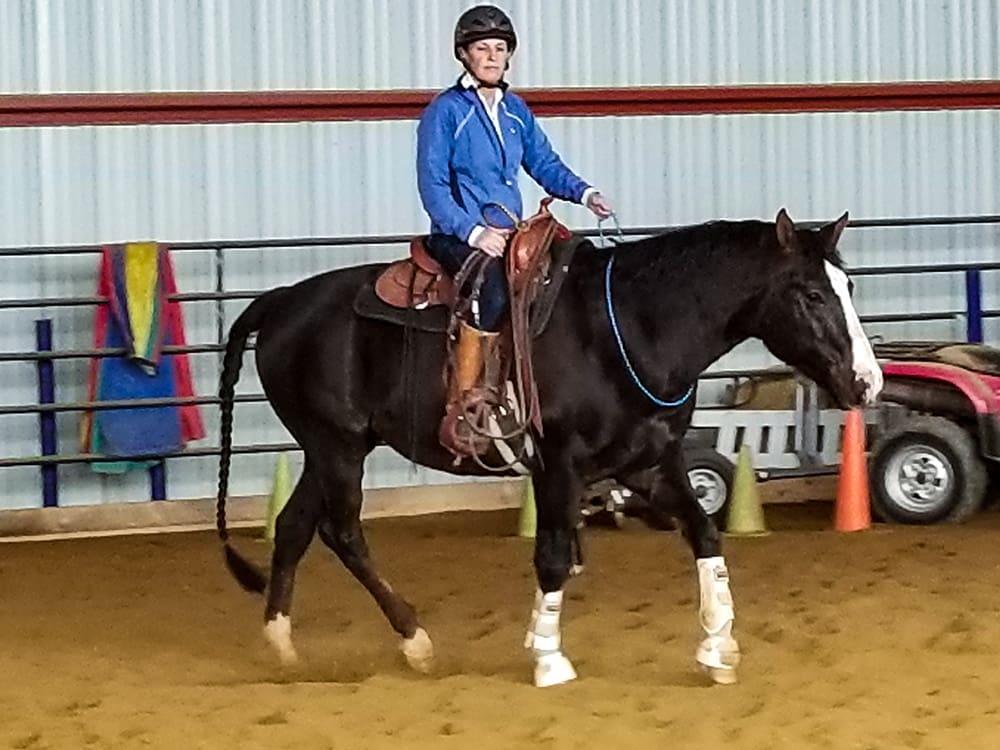I asked Julie to tell me a little about why she loves cow work and how it has improved her overall riding.
Read on to find out what Julie loves about cow work, then check out Julie’s upcoming ranch riding clinics!
Julie, when did you first start working cattle?
It wasn’t until I graduated from college and moved to Colorado that I first enjoyed the thrill of working cattle from a horse. After the hunter/jumper identity of my youth and the race track jobs of college, I was eager to try something totally new with horses and learning about western performance horses became my personal ambition. My professional ambition still kept me busy teaching people and training horses of all persuasions, so it was really only in my down-time that I got to pursue the nitty-gritty work of the cow horse.
Since I already knew a lot about herding, from a lifetime spent with horses, moving cattle, rating cattle and sorting cattle was easy for me to understand, in concept. But putting it into practice, slowing down the high-adrenalin rush that comes with working cattle and learning the precision of the technique takes a lifetime to master. I’ve had the opportunity to train with many great cow horse trainers over the years and continue to study as much as I can, but not as much as I’d like to. Like a lot of you, my real job keeps me pretty busy.
Working with cow horses that are bred for the sport and live to conquer the cow, is a thrill all its own. The concept of letting a horse do his job and think on his own, of putting your hand down on the neck and trusting the horse to do the job for which he was selectively bred for many generations is an important lesson in letting go. Working with an incredibly cowy horse and keeping him well-disciplined while letting him think and work on his own is an interesting exercise in trust.
What did it feel like to rope your first cow?
I never really threw my first loop until about 10 years ago. After more than 40 years of riding, the most important thing for me to work on in roping was building a loop (the first great challenge), throwing with accuracy and learning when and where to swing and throw. Unfortunately I was not very disciplined about practicing on the dummy but fortunately, I had a finished rope horse that was great on both ends and knew exactly how to get you to the right spot to throw. So I did practice some. He taught me a lot, once I managed to learn how to handle a rope.
I’ve taken a bunch of roping clinics and learned from some top-notch pros in the sport, from Florida to Hawaii. Beyond rope handling, rating a cow and throwing with accuracy, you have to learn how to dally and stop a cow and that is the tricky part—the part where you can lose your thumb. From ponying colts for years, the dally wasn’t too foreign to me and again, with good instruction, I learned to dally fast, safe and without looking down (thank you Charlie).
I threw a bunch of loops at live cows before I finally caught one. It turned out my first catch was during a competition—quadrupling the thrill that comes with roping, catching and stopping a running cow. I had participated in a ranch roping clinic the day before with one of my favorite clinicians, Merritt Linke. The day of the competition, I sat outside the arena with Merritt and watched the dozens of competitors that went before me. He showed me the predictable pattern the cows were following and where the sweet spot in the arena was to throw your loop. Rider after rider, I saw the cows turn and memorized that spot in the arena and now many strides before it I would start my swing.
It was the working ranch horse class—the hardest of the five classes of versatility ranch horse competition. First you ride a reining pattern, then call for a cow, box the cow on the end of the arena, turn him twice on the long fence, then get your rope out, build a loop while you are following the cow and rating him, then throw, catch and stop the cow. All of this within six minutes of entering the arena, so there is a little time pressure.
My horse reined well, boxed brilliantly, then we took the cow down the fence and made two high-speed turns. I got out my rope as we loped behind the cow, my horse patiently rating the cow while I built my loop. Then I looked up and saw we were about two strides away from the sweet spot—just enough time for two swings and a throw. It was exactly as I visualized talking to Merritt but still I was stunned as I watched the loop settled around her neck, seemingly in slow motion. Miraculously, I kept my wits about me long enough to straighten out with the cow, dally and stop. What a thrill! What an honor to ride such and incredible horse that works so hard in so many different things and teaches me how to ride.
How has learning cow work impacted your riding?
First, what I love about good cow horses is how athletic they are, quick thinking and even quicker reacting. To work cattle head-to-head like with cutting, with a horse that is hooked on to the cow so hard that every cell in his body is attuned and you are just along for the ride—one hand on the horn, pushing yourself back into the saddle while your rein hand sits on the neck of the horse, sitting back and trusting him to do his job. The stops and turns the horse makes on his own cause a real rush of adrenalin; staying in the middle of the horse and staying out of his way requires balance, relaxation of all your joints, good reflexes and the ability to move with the horse exactly as he moves.
Turning a big cow running at full speed down the long side of the pen is a thrill that has to be equivalent to sky diving, but you’re much closer to the ground. When I was youthful, I got this kind of thrill from riding jumpers; in college it was race horses. Now, to me, the ultimate ride is on the back of a good cow horse.
Cutting horses and reined cow horses are among the most elite equine athletes. To be able to ride one, knowing that it is trained and bred to do the job, with only your occasional guidance, and knowing that at best, you will stay out of the horse’s way as he performs, makes you want to become the best rider you can for your horse.
The skills of the ranch horse are many and varied—trail obstacles, riding a pattern of transitions similar to dressage, reining maneuvers, cutting, working cattle, dragging logs, roping, opening gates. Having total body control from head to tail and being able to put your horse in any situation and rely totally on his compete obedience. Any one of these pursuits are fun and challenging; to have a variety of things to work on keeps the horse and rider fresh.
What does it teach you about your horse?
Moving and controlling cattle is like herding horses. Understanding and putting into practice all the spatial understanding involved in herding, learning the balance points, how to move cows slowly, one step at a time and control their every movement makes you a better horseman too since horses and cattle behave the same way in this respect. Whether you are working a horse in a round pen, on a lead line, in a pen full of horses or even riding in a group, it is useful to know how to move horses and where the pressure points are.
Working with a horse bred to work cattle is much like working with a champion border collie or retriever. They instinctively know how to do their job and they live for every moment of working cattle. The rider just keeps the horse correct and makes him follow the rules of play, work on command and remain obedient to the rider. One thing I learned about my over-zealous cow horse is that his reward for performing correctly is getting to work the cow. If every time he makes a mistake, I pull him off the cow as punishment and he has to endure his personal walk of shame for losing the cow, those mistakes soon disappear.
Not all horses can become high-level cutters or cow horses; most are not athletic enough and not all horses will be cowy enough to hook onto a cow intensely. However, most horses can learn the job of a ranch horse and although they may not be naturals, they can be taught how to work a cow with the rider’s help. The same could be said for jumping.
In versatility, since the ranch horse has to do all the tasks of the ranch horse, he may be a jack-of-all-trades and a master of none. Hence the term “ranch cutter.” In ranch cutting, the rider is not penalized for assisting the horse and picking up his hand from the neck for guidance while he is cutting. The ranch cutter may never beat a “hand down” cutter, but if he performs well in all the other disciplines, he’ll rise quickly to the top in the competition.
What skills does it help even if you don’t necessarily want to compete in cutting or cow events? What’s the benefit for all?
Learning total body control of your horse and how to communicate with imperceptible aids through transitions and turns. Working in partnership with a horse that is totally obedient and willing to listen to the cues of the rider in any situation that might occur on the ranch. Challenging yourself and your partnership with your horse to try new things, cross new obstacles, teach a horse to work cattle. Set a variety of goals to improve your own horsemanship and your horse’s training, while having fun and never getting stuck in a rut. Even if you never worked a cow, learning the skills required of a cow horse—go forward willingly, stop, turn, back, leg yield, stay calm and focused—are sure to improve your horsemanship and your horse’s training and are lofty goals.
In my ranch horse clinics, we work on understanding the requirements and skills of the working ranch horse; the classes and procedures, the rules and philosophies of judging versatility ranch horse competition. We explore the skills required of the horses and riders; and work to progress toward those goals. Join me there: http://juliegoodnight.com/clinics/chino.html
–Julie Goodnight
I asked Julie to tell me a little about why she loves cow work and how it has improved her overall riding.
Read on to find out what Julie loves about cow work, then check out Julie’s upcoming ranch riding clinics!
Julie, when did you first start working cattle?
It wasn’t until I graduated from college and moved to Colorado that I first enjoyed the thrill of working cattle from a horse. After the hunter/jumper identity of my youth and the race track jobs of college, I was eager to try something totally new with horses and learning about western performance horses became my personal ambition. My professional ambition still kept me busy teaching people and training horses of all persuasions, so it was really only in my down-time that I got to pursue the nitty-gritty work of the cow horse.
Since I already knew a lot about herding, from a lifetime spent with horses, moving cattle, rating cattle and sorting cattle was easy for me to understand, in concept. But putting it into practice, slowing down the high-adrenalin rush that comes with working cattle and learning the precision of the technique takes a lifetime to master. I’ve had the opportunity to train with many great cow horse trainers over the years and continue to study as much as I can, but not as much as I’d like to. Like a lot of you, my real job keeps me pretty busy.
Working with cow horses that are bred for the sport and live to conquer the cow, is a thrill all its own. The concept of letting a horse do his job and think on his own, of putting your hand down on the neck and trusting the horse to do the job for which he was selectively bred for many generations is an important lesson in letting go. Working with an incredibly cowy horse and keeping him well-disciplined while letting him think and work on his own is an interesting exercise in trust.
What did it feel like to rope your first cow?
I never really threw my first loop until about 10 years ago. After more than 40 years of riding, the most important thing for me to work on in roping was building a loop (the first great challenge), throwing with accuracy and learning when and where to swing and throw. Unfortunately I was not very disciplined about practicing on the dummy but fortunately, I had a finished rope horse that was great on both ends and knew exactly how to get you to the right spot to throw. So I did practice some. He taught me a lot, once I managed to learn how to handle a rope.
I’ve taken a bunch of roping clinics and learned from some top-notch pros in the sport, from Florida to Hawaii. Beyond rope handling, rating a cow and throwing with accuracy, you have to learn how to dally and stop a cow and that is the tricky part—the part where you can lose your thumb. From ponying colts for years, the dally wasn’t too foreign to me and again, with good instruction, I learned to dally fast, safe and without looking down (thank you Charlie).
I threw a bunch of loops at live cows before I finally caught one. It turned out my first catch was during a competition—quadrupling the thrill that comes with roping, catching and stopping a running cow. I had participated in a ranch roping clinic the day before with one of my favorite clinicians, Merritt Linke. The day of the competition, I sat outside the arena with Merritt and watched the dozens of competitors that went before me. He showed me the predictable pattern the cows were following and where the sweet spot in the arena was to throw your loop. Rider after rider, I saw the cows turn and memorized that spot in the arena and now many strides before it I would start my swing.
It was the working ranch horse class—the hardest of the five classes of versatility ranch horse competition. First you ride a reining pattern, then call for a cow, box the cow on the end of the arena, turn him twice on the long fence, then get your rope out, build a loop while you are following the cow and rating him, then throw, catch and stop the cow. All of this within six minutes of entering the arena, so there is a little time pressure.
My horse reined well, boxed brilliantly, then we took the cow down the fence and made two high-speed turns. I got out my rope as we loped behind the cow, my horse patiently rating the cow while I built my loop. Then I looked up and saw we were about two strides away from the sweet spot—just enough time for two swings and a throw. It was exactly as I visualized talking to Merritt but still I was stunned as I watched the loop settled around her neck, seemingly in slow motion. Miraculously, I kept my wits about me long enough to straighten out with the cow, dally and stop. What a thrill! What an honor to ride such and incredible horse that works so hard in so many different things and teaches me how to ride.
How has learning cow work impacted your riding?
First, what I love about good cow horses is how athletic they are, quick thinking and even quicker reacting. To work cattle head-to-head like with cutting, with a horse that is hooked on to the cow so hard that every cell in his body is attuned and you are just along for the ride—one hand on the horn, pushing yourself back into the saddle while your rein hand sits on the neck of the horse, sitting back and trusting him to do his job. The stops and turns the horse makes on his own cause a real rush of adrenalin; staying in the middle of the horse and staying out of his way requires balance, relaxation of all your joints, good reflexes and the ability to move with the horse exactly as he moves.
Turning a big cow running at full speed down the long side of the pen is a thrill that has to be equivalent to sky diving, but you’re much closer to the ground. When I was youthful, I got this kind of thrill from riding jumpers; in college it was race horses. Now, to me, the ultimate ride is on the back of a good cow horse.
Cutting horses and reined cow horses are among the most elite equine athletes. To be able to ride one, knowing that it is trained and bred to do the job, with only your occasional guidance, and knowing that at best, you will stay out of the horse’s way as he performs, makes you want to become the best rider you can for your horse.
The skills of the ranch horse are many and varied—trail obstacles, riding a pattern of transitions similar to dressage, reining maneuvers, cutting, working cattle, dragging logs, roping, opening gates. Having total body control from head to tail and being able to put your horse in any situation and rely totally on his compete obedience. Any one of these pursuits are fun and challenging; to have a variety of things to work on keeps the horse and rider fresh.
What does it teach you about your horse?
Moving and controlling cattle is like herding horses. Understanding and putting into practice all the spatial understanding involved in herding, learning the balance points, how to move cows slowly, one step at a time and control their every movement makes you a better horseman too since horses and cattle behave the same way in this respect. Whether you are working a horse in a round pen, on a lead line, in a pen full of horses or even riding in a group, it is useful to know how to move horses and where the pressure points are.
Working with a horse bred to work cattle is much like working with a champion border collie or retriever. They instinctively know how to do their job and they live for every moment of working cattle. The rider just keeps the horse correct and makes him follow the rules of play, work on command and remain obedient to the rider. One thing I learned about my over-zealous cow horse is that his reward for performing correctly is getting to work the cow. If every time he makes a mistake, I pull him off the cow as punishment and he has to endure his personal walk of shame for losing the cow, those mistakes soon disappear.
Not all horses can become high-level cutters or cow horses; most are not athletic enough and not all horses will be cowy enough to hook onto a cow intensely. However, most horses can learn the job of a ranch horse and although they may not be naturals, they can be taught how to work a cow with the rider’s help. The same could be said for jumping.
In versatility, since the ranch horse has to do all the tasks of the ranch horse, he may be a jack-of-all-trades and a master of none. Hence the term “ranch cutter.” In ranch cutting, the rider is not penalized for assisting the horse and picking up his hand from the neck for guidance while he is cutting. The ranch cutter may never beat a “hand down” cutter, but if he performs well in all the other disciplines, he’ll rise quickly to the top in the competition.
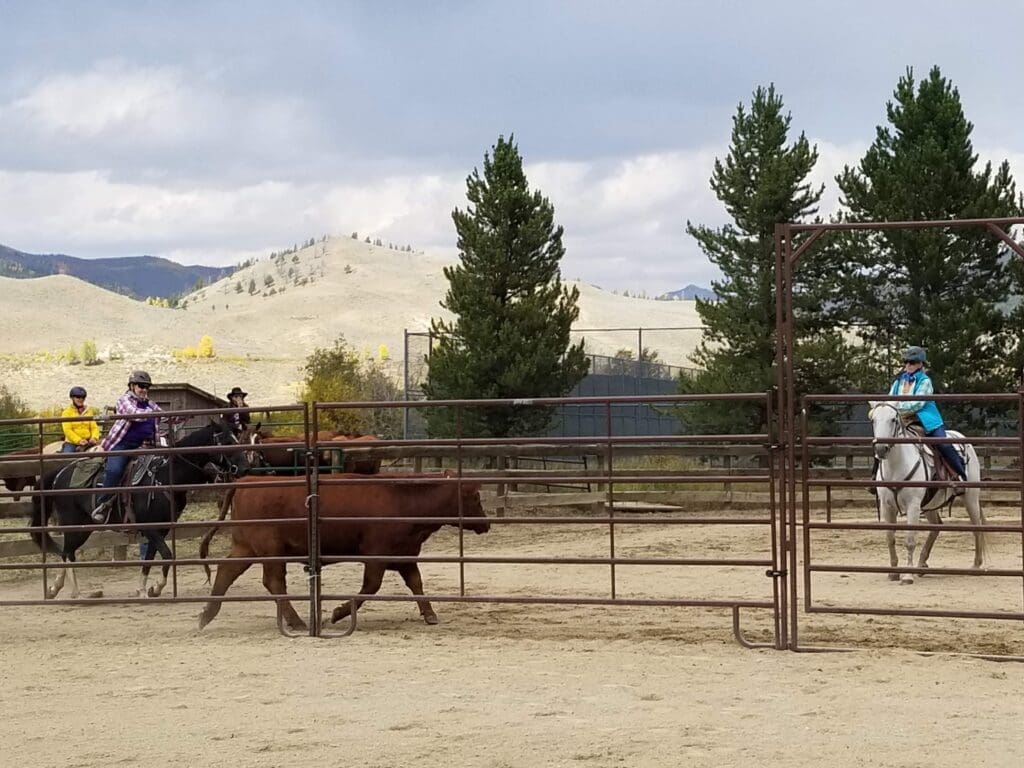
What skills does it help even if you don’t necessarily want to compete in cutting or cow events? What’s the benefit for all?
Learning total body control of your horse and how to communicate with imperceptible aids through transitions and turns. Working in partnership with a horse that is totally obedient and willing to listen to the cues of the rider in any situation that might occur on the ranch. Challenging yourself and your partnership with your horse to try new things, cross new obstacles, teach a horse to work cattle. Set a variety of goals to improve your own horsemanship and your horse’s training, while having fun and never getting stuck in a rut. Even if you never worked a cow, learning the skills required of a cow horse—go forward willingly, stop, turn, back, leg yield, stay calm and focused—are sure to improve your horsemanship and your horse’s training and are lofty goals.
In my ranch horse clinics, we work on understanding the requirements and skills of the working ranch horse; the classes and procedures, the rules and philosophies of judging versatility ranch horse competition. We explore the skills required of the horses and riders; and work to progress toward those goals.
–Julie Goodnight
Check out Julie’s events HERE
Join Julie’s Library Membership for tons of Training Advice HERE
